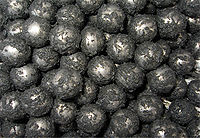Difference between revisions of "Ball Dryers"
| (One intermediate revision by the same user not shown) | |||
| Line 7: | Line 7: | ||
* Please start editing this page after the /noinclude | * Please start editing this page after the /noinclude | ||
* -------------------------------------------------></noinclude> | * -------------------------------------------------></noinclude> | ||
[[File:Ball_Dryers.jpg|thumb|right|200px| | [[File:Ball_Dryers.jpg|thumb|right|200px|Dryer Balls]] | ||
The '''Ball Dryers''' | The '''Ball Dryers''' or [[Delta Dryers]] work by improving the circulation of heat and air through the wet items. Steel balls are a perfect medium for transferring heat. In 1985 three Japanese researchers had already come up with the idea of using hot, steel balls to dry sludge (or radioactive waste in their case). They applied for and received a patent for the idea, but their invention solves only half the problem. The question remains of what to do with the water that evaporates from the sludge? Just carrying off the vapour wastes a lot of energy, which is why the Japanese patent never grew into a commercial application. A method called multiple-stage flash evaporation is often used to extract drinking water from sea water. Sea water is heated until the water evaporates (the salt remains) and the water vapour is then turned into condensate. The heat produced by the condensation process is then reused very efficiently. The best way of doing this is by reducing the pressure in a number of stages. The technology is used on a large scale commercially. | ||
The | |||
Latest revision as of 20:16, 19 August 2012
The Ball Dryers or Delta Dryers work by improving the circulation of heat and air through the wet items. Steel balls are a perfect medium for transferring heat. In 1985 three Japanese researchers had already come up with the idea of using hot, steel balls to dry sludge (or radioactive waste in their case). They applied for and received a patent for the idea, but their invention solves only half the problem. The question remains of what to do with the water that evaporates from the sludge? Just carrying off the vapour wastes a lot of energy, which is why the Japanese patent never grew into a commercial application. A method called multiple-stage flash evaporation is often used to extract drinking water from sea water. Sea water is heated until the water evaporates (the salt remains) and the water vapour is then turned into condensate. The heat produced by the condensation process is then reused very efficiently. The best way of doing this is by reducing the pressure in a number of stages. The technology is used on a large scale commercially.
